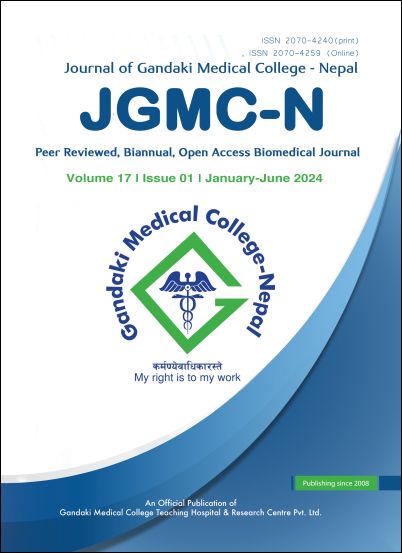Comparison of tooth size and arch width of crowded and uncrowded Class I occlusion in individuals visiting a tertiary care center in Nepal
DOI:
https://doi.org/10.3126/jgmcn.v17i1.66486Keywords:
Arch width, class I malocclusion, crowding, tooth sizeAbstract
Introduction: The knowledge of tooth width and arch size is essential for esthetic and orthodontic rehabilitation. Hence, this study was done to assess the extent to which the arch width and mesiodistal tooth size were responsible for the crowding in individuals visiting a tertiary care center in Nepal.
Methods: This was a cross-sectional study conducted on dental casts which was divided into two groups. The first group consisted 30 casts of normal occlusions (15 males and 15 females) without crowding. The second group consisted same number of casts exhibiting class I malocclusion with crowding. Mesiodistal teeth dimensions and arch width were measured. The data was analyzed using an independent sample t-test with a level of significance set at p<0.05.
Results: Statistically significant difference in mesiodistal width of the upper central incisor ( 1st group 8.5±0.33, 2nd group 9.26±0.47; p-value=0.027) and canine (1st group 7.52±1.03, 2nd group 8.14±0.34; p-value=0.012), lower canine (1st group 6.38±0.84, 2nd group 7.12±0.38; p-value=0.005), 1st (1st group 6.63±0.81, 2nd group 7.23±0.46; p-value =0.023) and 2nd (1st group 6.66±0.85, 2nd group 6.97±0.52; p-value=0.035) premolar was observed. Buccal intercanine width of the maxillary and mandibular arch (1st group 38.25± 3.14, 2nd group 36.45 ± 1.44; p-value=0.003 and 1st group 30.88±1.6, 2nd group 25.48± 0.75; p-value=0.05 respectively), maxillary buccal intermolar width (1st group 58.44±5.0, 2nd group 55.75± 1.7; p-value=0.001), mandibular buccal (1st group 56.75± 4.2, 2nd group 55.30±2.12; p-value=0.013) and lingual intermolar width (1st group 32.50±3.4 , 2nd group 28.73±1.88; p-value=0.036) were found to be larger in the first group.
Conclusions: The results of this study suggest that both the tooth size and arch width has a role in developing crowding.
Downloads
Downloads
Published
How to Cite
Issue
Section
License
Copyright (c) 2024 The Author(s)

This work is licensed under a Creative Commons Attribution-NonCommercial 4.0 International License.
This license allows reusers to distribute, remix, adapt, and build upon the material in any medium or format for noncommercial purposes only, and only so long as attribution is given to the creator.

